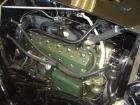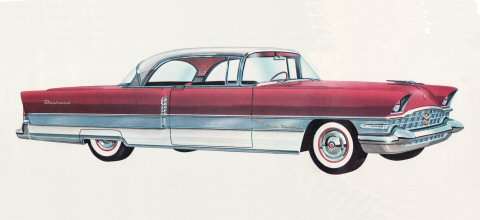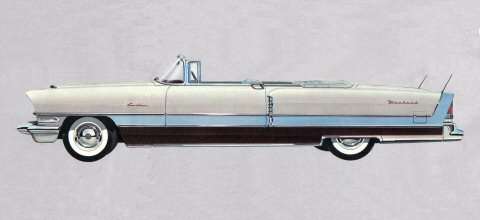|
Valve Guide Reaming
|
||||
|---|---|---|---|---|
|
Home away from home
|
Hey all - going to be installing valve guides in my '50 327 block, curious about the appropriate reamer for this. The manual calls for a 11/32" reamer. From Goodson tools, would I want to go with a .343" or .3435", but they don't have something that specifically says 11/32, which is really .34375". Sorry to be a pedant again. They suggested the .343, but I just wanted to confirm this is what other folks would do.
Also, is this the type of reamer I would be looking for:goodson.com/products/1-4-drive-high-speed-steel-reamers?variant=33471808582 Thanks, all!
Posted on: 2/26 15:28
|
|||
|
Joe B.
Greenville, NC 1950 Super Deluxe Eight Touring Sedan, Model 2302-5 327 w/ Ultramatic, 6v+ |
||||
|
||||
|
Re: Valve Guide Reaming
|
||||
|---|---|---|---|---|
|
Home away from home
|
I don't know the exact spec for your engine, but usually something like 3 thou intake and 5 thou exhaust play is preferred. Between 0.3435 and 0.34375 is only 0.25 thou. So it won't matter, and you will actually be taking up 0.25 thou diametral wear on the valve stem.
Posted on: 2/26 16:44
|
|||
|
1955 400 | Registry | Project Blog
1955 Clipper Deluxe | Registry | Project Blog 1955 Clipper Super Panama | Registry Email (Parts/service inquiries only, please. Post all questions on the forum.) service@ultramatic.info |
||||
|
||||
|
Re: Valve Guide Reaming
|
||||
|---|---|---|---|---|
|
Home away from home
|
Quote:
.002" and .004" clearance for my 327.
Posted on: 2/26 17:26
|
|||
|
||||
|
Re: Valve Guide Reaming
|
||||
|---|---|---|---|---|
|
Home away from home
|
I think I've got this figured out. The specs on the stems on a new set of valves from Egge are:
Intake: .3425 Exhaust: .3400 So to achieve the .002 (intake) and .004 (exhaust), I would actually want a .344" reamer. Am I thinking about that correctly?
Posted on: 2/26 19:14
|
|||
|
Joe B.
Greenville, NC 1950 Super Deluxe Eight Touring Sedan, Model 2302-5 327 w/ Ultramatic, 6v+ |
||||
|
||||
|
Re: Valve Guide Reaming
|
||||
|---|---|---|---|---|
|
Home away from home
|
Joe, the above gents giving you precise advice, but wanted to add that a veteran mechanist here in the CA Bay Area who's rebuilt many such Packard engines as your 327, my earlier 356, and those of the '30s has satisfactorily gotten various tools and supplies from Goodsons, per above. I defer to the previous posters, but on a 356, you want the valve guides looser than would be acceptable on a modern V-8, noting the poster above who didn't even have to ream his. Perhaps this is the case in all Packard L-head engines from the 120/110 of the '30s and everything else through 1954. (A 356 is just a glorified 120 with four more main bearings for marketing's sake, as are its hydraulic valve lifters, and shared some of the tooling with the same bore 110 six.)
Make sure to smear plenty of cam lube on everything metal to metal. Though most of us use any major brand full synthetic 10W/30 as the best viscosity and protection, some feel more comfortable using a higher zinc content motor oil like PennGrade 1 "The Original Green Oil" semi-synthetic 10W/30 after and only after a polished cam, freshened/polished lifters, as does the machinist cited above. However, Packard savant Ross Miller, Speedwell Garage, MD, who knows more than any of us here gathered, says he uses any name brand 10W/30 from the outset, and has done so for decades in cars that are driven. So using a higher zinc content oil only after such engine work might be beneficial, but more likely dated juju. I'd like not hearsay, but an SAE-worthy study on vintage side-valve engines like ours in o n l y this situation, because full-synthetic 10W/30 is otherwise all you need, and do n o t use Diesel oil as some do, because it is formulated to deal with the much higher ash content of such engines, not gasoline engines. Follow the Packard shop manual and do not reinvent the wheel.
Posted on: 2/26 23:27
|
|||
|
||||
|
Re: Valve Guide Reaming
|
||||
|---|---|---|---|---|
|
Home away from home
|
Here is the oil that Ross recommended me:rotella.shell.com/en_us/products/triple- ... 3JvdGVsbGEvbmV3c2xldHRlci9lbl91cw==
Joe, you may note that "high zinc" oils simply did not exist when your engine was engineered and manufactured, hence they are unnecessary.
Posted on: 2/27 0:25
|
|||
|
1955 400 | Registry | Project Blog
1955 Clipper Deluxe | Registry | Project Blog 1955 Clipper Super Panama | Registry Email (Parts/service inquiries only, please. Post all questions on the forum.) service@ultramatic.info |
||||
|
||||
|
Re: Valve Guide Reaming
|
||||
|---|---|---|---|---|
|
Home away from home
|
Before hunting for a reamer, maybe replace your guides and check to see if your clearances are within spec?
Of all of the projects that I've done on my car, replacing valve guides was the one where I found myself over my head. Truth be told I'm in over my head on most of my Packard projects, but with the valve guides I was having visions of hauling my car to someone that could bail me out, but all's well that ends well. It was a happy day when I finally got my old guides out and the new ones installed. (My engine work was all done in-car.) To be clear, I am not a mechanic, only mechanically inclined. Thankfully my car is very patient and responds well to my persistent need to repair and rebuild it.  Here are a few pictures. I started pulling my engine apart to find the source of a tapping sound on the May long weekend 2023. I didn't get it put back together and running until August, just in time for the Packard/Studebaker annual picnic.     
Posted on: 2/27 1:53
|
|||
|
||||
|
Re: Valve Guide Reaming
|
||||
|---|---|---|---|---|
|
Home away from home
|
Thanks so much, guys! I've been running the Lucas Oil Classic Car 10w-40 oil and have been very pleased.
53Cav - I so envy that beefy driver! I'm about 1/4 the way through removing the guides. It hasn't been an awful exercise, I've read the other threads on this topic about seven hundred times. Threaded rod method works great on the intake guides. The exhaust guides just start to crumble on the bottom, so I've had to drive those out and chiseling. And of course, guide #16 is an exhaust valve, hiding conveniently under the cowl (the engine is still in the car here, too). We'll get there! I wanted to jump on the reamer because even before installing, one of my intake valves felt like it was catching something in the new guide. Of course, this is why it's getting new valves, too, and their was definite visible wear on the stems of the first valves I pulled. One thing I found interesting in your pictures was the oil ring on your piston. I wonder why those look so different (other than one is pretty old and the other is pretty new). So yeah, plan is to just start fresh on pretty much every valve train component excellent for the washers and keepers.
Posted on: 2/27 10:12
|
|||
|
Joe B.
Greenville, NC 1950 Super Deluxe Eight Touring Sedan, Model 2302-5 327 w/ Ultramatic, 6v+ |
||||
|
||||
|
Re: Valve Guide Reaming
|
||||
|---|---|---|---|---|
|
Home away from home
|
I'm running Lucas Classic Car oil as well. There are LOTS of opinions about oil, sooooo many opinions, but I think the best thing we can do for our engines is more frequent changes. The oil in these engines becomes contaminated much quicker than it does in modern engines.
I could not get my valve guides to budge using the threaded rod method, which is the point where I got a bit nervous. But I had our local machine shop build up the driver and that did the trick! I had them all out in an hour! Because I was driving mine out, and because cylinder 8's guides were very close to spec, I left them alone. #4 & #5 had very worn guides. I too noticed stem wear on my valves, primarily on one side of the stem. I suppose this is typical, but this is the only engine I've worked on, so not sure. Here's a picture of a piston with the rings is did have on it when I pulled my engine apart. The oil ring looks similar to the new one, but my engine had been worked on sometime in the past, so has probably had one new set of rings. I'm guessing the engine work was done in the 80's, and then I think it was parked for a long time. Probably because of a tapping sound that the engine was making. The engine builder that I know, and would go to for advice, generally uses Hasting rings, but I showed him the set of Grant rings I got for the car and he was impressed with design.  Take lots and lots of pictures! They are good for future reference. I love driving my '53 Cavalier! I'm sure your '50 rides and handles much the same. Your engine will be purring soon!
Posted on: 2/27 11:05
|
|||
|
||||

 20250227_100620.jpg (443.04 KB)
20250227_100620.jpg (443.04 KB)







